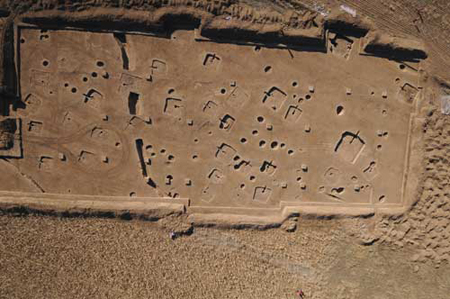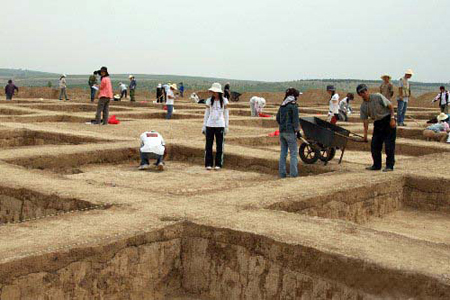The Hongshan Culture Settlement Site at Weijiawopu , Chifeng of Inner Mongolia
Weijiawopu site is located 2 kilometers to the northeastern Weijiawopu Village, Wenzhong Town, Hongshan District of Chifeng, which is on a terrace. In the nation-wide cultural survey conducted in May 2008 and a full-scale archaeological survey conducted by the Cultural Relics and Archaeological Institute of Inner Mongolia Autonomous Region from October to November 2008, a rounded ditch settlement site of Hong Shan Culture was identified. Starting from 2009, the Institute and the Jilin University Research Center for Chinese Frontier Archaeology (RCCFA) jointly conduct an archaeological excavation.
From 9th July to 15th October 2010, the joint excavation team had conducted another archaeological excavation for 3 months.

The 2010 excavated area was situated at the eastern part of the site and the sea level datum was 725 to 726m with a landscape slanting from southwest to northeast. There were 30 grids measuring 5m x 5m and 33 grids measuring 10m x 10m. The total excavated area was 4117.25 square meters, including the grids extensions. There were 36 house foundations, 62 ash pits, 2 ash trenches and 4 stoves of the Hongshan Culture period.
Shapes of the Hongshan Culture ash pits found within the site including circular, ellipse, square with circular corner and irregular. The structure of the pit including straight cylindrical, reverse trapezium, bag shape, pot’s bottom and etc. The bottom of the pit can be divided into flat and stepped style. House foundation was either crypt or semi crypt, which plan shapes are square with circular, trapezium, quadrilateral and so forth. The area measured from 10 sq. meters to 50 sq. meters.

Huge amount of the Hongshan Culture’s artefacts were unearthed from the site and the majority was pottery with a certain amount of stone tools and few bone tools. Pottery can be divided into sandy pottery and clay pottery. More than 60% was sandy pottery and clay pottery came second. Most of pottery were decorated in zigzag pattern, more than 20% in total. Incised, stamped and pressed patterns were also identified. A few amount of knitted, corded pattern and painted pottery can be found. For the painted pottery, most of them were in red with string patterns, zigzag lines, geometric square and triangular patterns. Only a few pottery were painted in black with triangular, parallel line pattern, etc. Most pottery were flat base, only few of them were rounded base or with foot rim. For the style of pottery, there were slanted opening container, Fu, pot with double ears, urn, pot with round belly, basin, pan, bowl, ding, lid, cup, pottery spinning wheel, pottery ball and so forth. Most of the stone tools were polished, chipped and microlithic, including stone grinder, stone stick, axe, adze, perforated stone knife, plow, anvil, grinding stone, stone arrowhead, stone decoration, blade, scraper, chopper and etc.
After analyzing the materials from the excavation, the dating of the site is around Early or Mid stages of the Honghan Culture.
Findings from the 2010 excavation certainly provide evidences for feature classification and dating, cultural assemblage compositions, habitation and subsistence strategies of the Hongshan Culture in Weijiawopu site. (Translator: Li Langlin)

